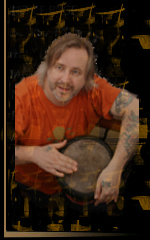|
Scroll down for text and PDF versions.
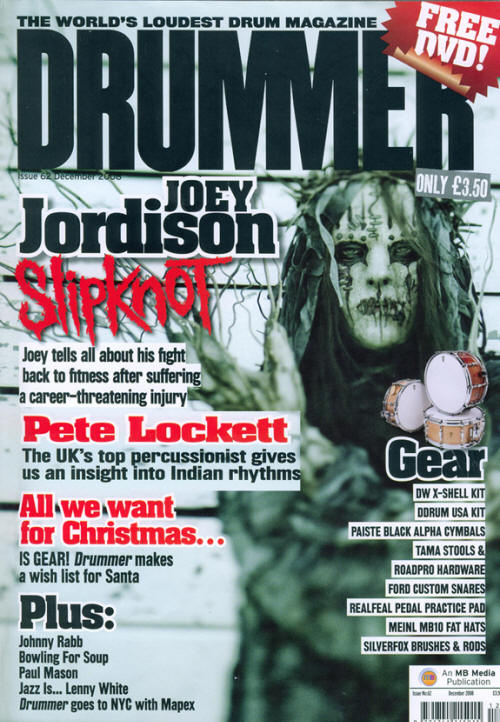
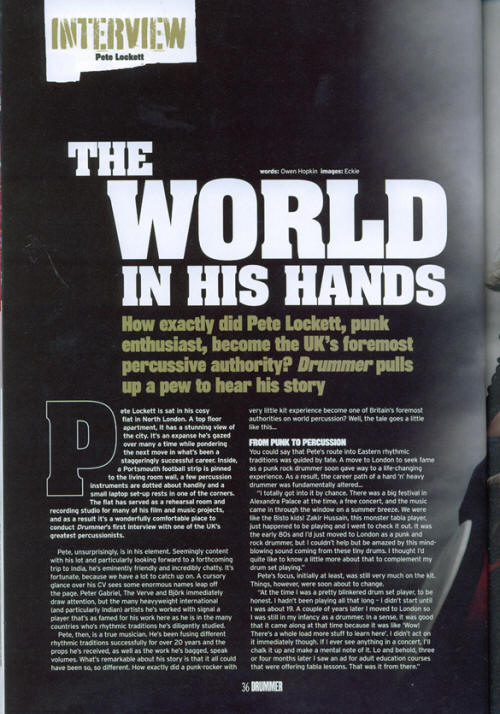
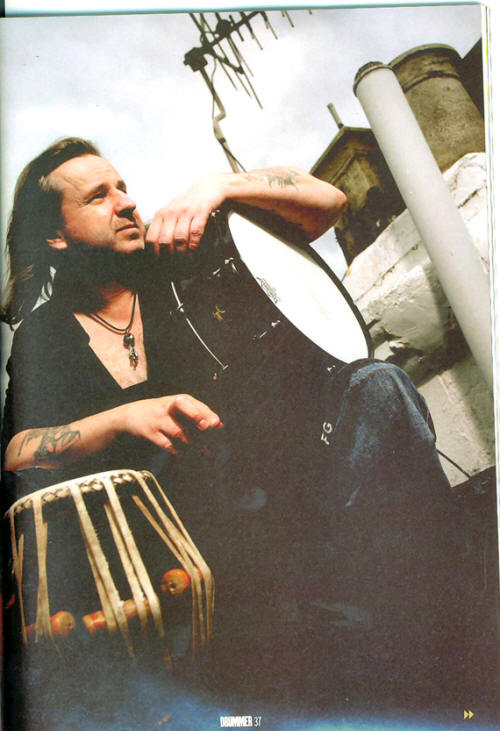
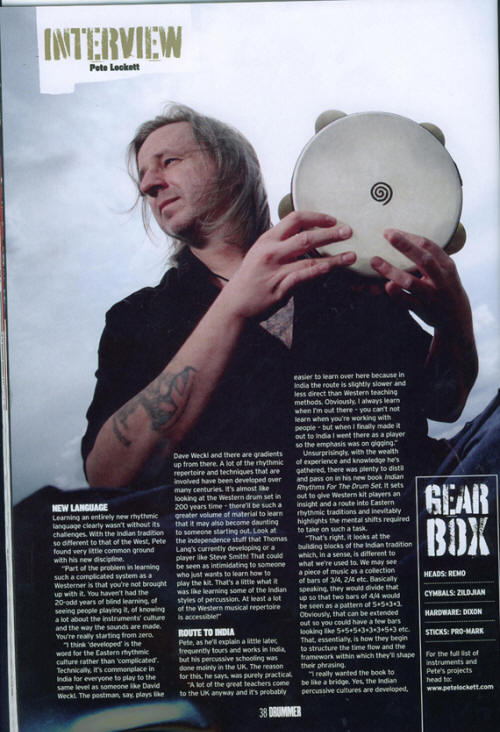
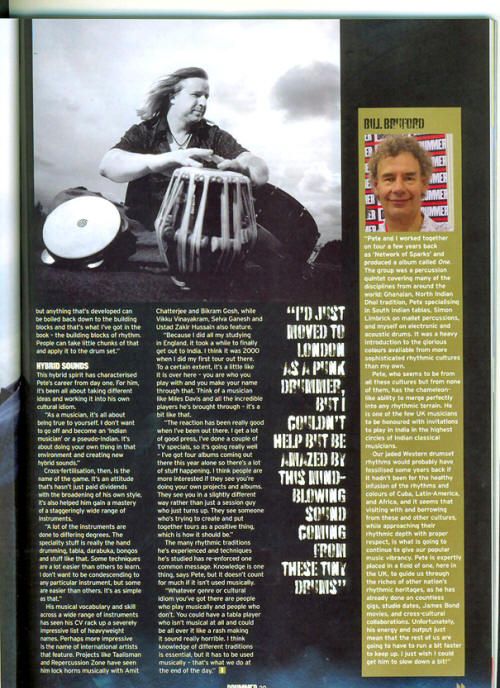
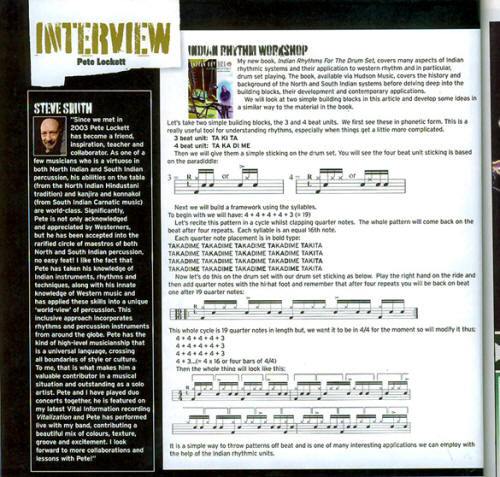
The World In His Hands
Words; Owen Hopkin. Photos; Eckie.
How exactly did Pete Lockett, punk enthusiast, become the UK's
foremost percussive authority? Drummer pulls up a pew to hear his story.
Pete Lockett is sat in his cosy flat in North London. A top floor
apartment, it has a stunning view of the city. It's an expanse he's
gazed over many a time while pondering the next move in what's been a
staggeringly successful career. Inside, a Portsmouth football strip is
pinned to the living room wall, a few percussion instruments are dotted
about handily and a small laptop set-up rests in one of the corners. The
flat has served as a rehearsal room and recording studio for many of his
film and music projects, and as a result it's a wonderfully comfortable
place to conduct Drummer's first interview with one of the UK's greatest
percussionists.
Pete, unsurprisingly, is in his element. Seemingly content with his lot
and particularly looking forward to a forthcoming trip to India, he's
eminently friendly and incredibly chatty. It's fortunate, because we
have a lot to catch up on. A cursory glance over his CV sees some
enormous names leap off the page. Peter Gabriel, The Verve and Bjork
immediately draw attention, but the many heavyweight international (and
particularly Indian) artists he's worked with signal a player that's as
famed for his work here as he is in the many countries' who's rhythmic
traditions he's diligently studied. Pete, then, is a true musician. He's
been fusing different rhythmic traditions successfully for over twenty
years and the props he's received, as well as the work he's bagged,
speak volumes. What's remarkable about his story is that it all could
have been so, so different. How exactly did a punk-rocker with very
little kit experience become one of Britain's foremost authorities on
world percussion? Well, the tale goes a little like this...
You could say that Pete's route into Eastern rhythmic traditions was
guided by fate. A move to London to seek fame as a punk rock drummer
soon gave way to a life-changing experience. As a result, the career
path of a hard'n'heavy drummer was fundamentally altered...
"I totally got into it by chance. There was a big festival in Alexandra
Palace at the time, a free concert, and the music came in through the
window on a summer breeze. We were like the Bisto kids! Zakir Hussein,
this monster Tabla player, just happened to be playing and I went to
check it out. It was the early 80s and I'd just moved to London as a
punk and rock drummer, but I couldn't help but be amazed by this
mind-blowing sound coming from these tiny drums. I thought I'd quite
like to know a little more about that to complement my drum set
playing".
Pete's focus, initially at least, was still very much on the kit.
Things, however, were soon about to change. "At the time I was a pretty
blinkered drum set player, to be honest. I hadn't been playing all that
long -- I didn't start until I was about 19. A couple of years later I
moved to London so I was still in my infancy as a drummer. In a sense,
it was good that it came along at that time because it was like 'Wow!
There's a whole load more stuff to learn here'. I didn't act on it
immediately though. If I ever see anything in a concert, I'll chalk it
up and make a mental note of it. Lo and behold, three or four months
later I saw an ad for adult education courses that were offering Tabla
lessons. That was it from there".
Learning an entirely new rhythmic language clearly wasn't without its
challenges. With the Indian tradition so different to that of the West,
Pete found very little common ground with his new discipline. "Part of
the problem in learning such a complicated system as a Westerner is that
you're not brought up with it. You haven't had the 20-odd years of blind
learning, of seeing people playing it, of knowing a lot about the
instruments' culture and the way the sounds are made. You're really
starting from zero.
"I think 'developed' is the word for the Eastern rhythmic culture rather
than 'complicated'. Technically, it's commonplace in India for everyone
to play to the same level as someone like David Weckl. The postman, say,
plays like Dave Weckl and there are gradients up from there. A lot of
the rhythmic repertoire and techniques that are involved have been
developed over many centuries. It's almost like looking at the Western
drum set in 200 years time -- there'll be such a greater volume of
material to learn that it may also become daunting to someone starting
out. Look at the independence stuff that Thomas Lang's currently
developing or a player like Steve Smith! That could be seen as
intimidating to someone who just wants to learn how to play the kit.
That's a little what it was like learning some of the Indian styles of
percussion. At least a lot of the Western musical repertoire is
accessible!"
Pete, as he'll explain a little later, frequently tours and works in
India, but his percussive schooling was done mainly in the UK. The
reason for this, he says, was purely practical. "A lot of the great
teachers come to the UK anyway and it's probably easier to learn over
here because in India the route is slightly slower and less direct than
Western teaching methods. Obviously, I always learn when I'm out there
-- you can't not learn when you're working with people -- but when I
finally made it out to India I went there as a player so the emphasis
was on gigging".
Unsurprisingly, with the wealth of experience and knowledge he's
gathered, there was plenty to distil and pass on in his new book ĎIndian
Rhythms For The Drum Setí. It sets out to give Western kit players an
insight and a route into Eastern rhythmic traditions and inevitably
highlights the mental shifts required to take on such a task.
"That's right, it looks at the building blocks of the Indian tradition
which, in a sense, is different to what we're used to. We may see a
piece of music as a collection of bars of 3/4, 2/4 etc. Basically
speaking, they would divide that up so that two bars of 4/4 would be
seen as a pattern of 5+5+3+3. Obviously, that can be extended out so you
could have a few bars looking like 5+5+5+3+3+3+5+3 etc. That,
essentially, is how they begin to structure the time flow and the
framework within which they'll shape their phrasing.
ďI really wanted the book to be like a bridge. Yes, the Indian
percussive cultures are developed, but anything thatís developed can be
boiled back down to the building blocks and thatís what Iíve got in the
book Ė the building blocks of rhythm. People can take little chunks of
that and apply it to the drum setĒ. This hybrid spirit has
characterised Peteís career from day one. For him, itís been all about
taking different ideas and working it into his own cultural idiom.
ďAs a musician, itís all about being true to yourself. I don't want to
go off and become an ĎIndian musicianí or a pseudo-Indian. It's about
doing your own thing in that environment and creating new hybrid
soundsĒ. Cross-fertilisation, then, is the name of the game. Itís an
attitude thatís hasnít just paid dividends with the broadening of his
own style, itís also helped him gain a mastery of a staggeringly wide
range of instruments.
ďA lot of the instruments are done to differing degrees. The speciality
stuff is really the hand drumming, Tabla, Darabuka, Bongos and stuff
like that. Some techniques are a lot easier than others to learn. I
donít want to be condescending to any particular instrument, but some
are easier than others. Itís as simple as thatĒ. His musical vocabulary
and skill across a wide range of instruments has seen his CV rack up a
severely impressive list of heavyweight names. Perhaps more impressive
is the name of international artists that feature. Projects like
Taalisman and Repercussion Zone have seen him lock horns musically with
Amit Chatterjee and Bickram Gosh, while Vikky Vinayakram, Selva Ganesh
and Ustad Zakir Hussain also feature.
ďBecause I did all my studying in England, it took a while to finally
get out to India. I think it was 2000 when I did my first tour out
there. To a certain extent, itís a little like it is over here Ė you are
who you play with and you make your name through that. Think of a
musician like Miles Davis and all the incredible players heís brought
through Ė itís a bit like that.
ďThe reaction has been really good when Iíve been out there. I get a lot
of good press, Iíve done a couple of TV specials, so it's going really
well -- I've got 4 albums coming out there this year alone so there's a
lot of stuff happening. I think people are more interested if they see
youíre doing your own projects and albums. They see you in a slightly
different way rather than just a session guy who just turns up. They see
someone whoís trying to create and put together tours as a positive
thing, which is how it should beĒ.
The many rhythmic traditions heís experienced and techniques heís
studied has re-enforced one common message. Knowledge is one thing, says
Pete, but it doesnít count for much if it isnít used musically.
ďWhatever genre or cultural idiom youíve got there are people who play
musically and people who donít. You could have a Tabla player who isnít
musical at all and could be all over it like a rash making it sound
really horrible. I think knowledge of different traditions is essential,
but it has to be used musically Ė thatís what we do at the end of the
dayĒ
Click for low res PDF of article
Click for HI res PDF of article


|

